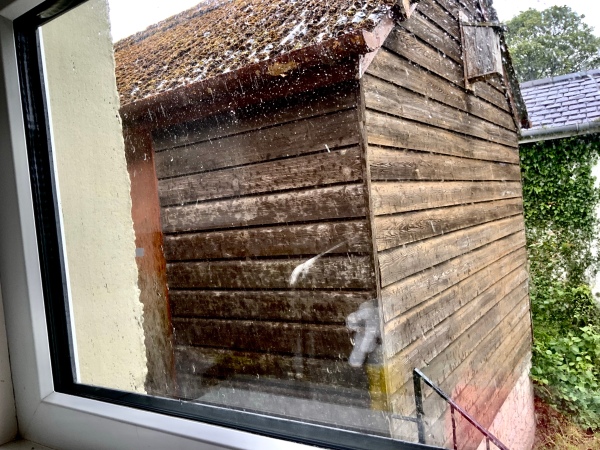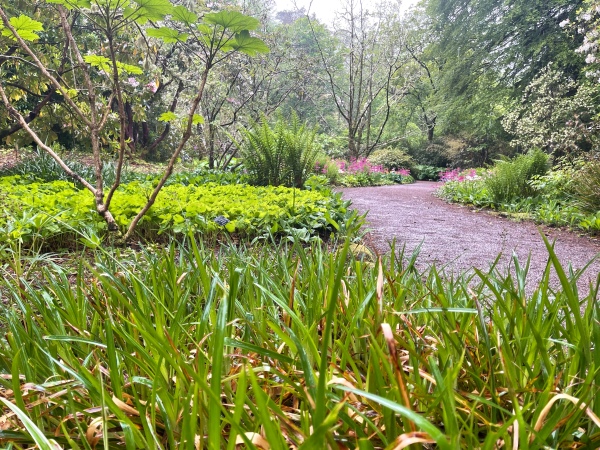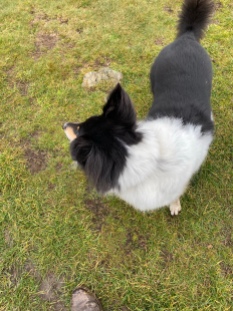
Continued from Part One.
I should have known, really…that our luck would run out, one day.
According to a close friend, who loves journeys into Scotland as much as we do, we are a ‘talisman’ for good weather. No less than six trips in a row – over several years – have seen us bathed in sunshine for most of the week. There have been exceptions, but they left you with the feeling that most of it had been good.

Original image by the author, taken at Inverewe Gardens)
The same friend states that we have seen an entirely different Scotland from most travellers, whose furtive presences are usually to be seen huddled in doorways and rushing into small general stores to buy those forever seen but never bought ‘rain jackets in a pocket’.
Something like this:

Didn’t we always look at them and ask who would buy such things? Well, for those who are following my agonised journey to warmth, I have an update for my cynical former self… They are the sort of garment that could save your life…albeit at the cost of your reputation.
This trip has seen us huddled into doorways, overhangs and barely watertight cafe extenstions (for that neglected breed – us dog owners) at least four times a day – when we have dared to get out of that warm capsule of transportation: the modern car.
We thought the spring would have arrived in the Scottish Highlands by the end of May. When we voice this in quiet, wet whispers, new-found friends, clutching their hands around large coffee mugs in hippy-themed cafes, smile at us, saying nothing. But we do notice they all have six layers of clothing…to our four.

I expected rain – it is Scotland, after all; but not so much cold. It’s relentless… As I sit here, writing at the kitchen table of our rented cottage in Poolewe (see last Tuesday’s post), the hailstones are bouncing off the roof of the nearby wooden shed belonging to the property.


But we’re not the kind of folk who sit in the house – our own or rented – moaning and dripping. One of the planned visits of our Scottish trip was to be Inverewe Botanical Gardens (pronounced ‘Inver – you’) , a famous horticultural landscape occupying the whole of one of the local headlands.

My wife, Bernie, is a qualified horticulturalist, and the botanical gardens at Inverewe were to be one of the highlights of this Scottish odyssey. It was early in our holiday, and even a wet walk along the curve of the bay seemed exciting, so we set off…

The estate is entered through the gates. The main gardens can optionally be entered by following the line of the shore. This – the walled garden – would have generated produce for the kitchen, and is not for decoration; but is a classic example of gardening organisation.

The 2,000 acre garden was created in 1862, on what used to be barren land, by Osgood Mackenzie. His rich mother bought him the land, presumably to set her son a challenge.

He set about tackling the difficulties inherent in a sea-facing setting; beginning with the establishment of a natural wind-break, then improving the soil to sustain the wide variety of planting he had in mind.

He began by planting a mixture of large trees and shrubs to form the windbreak. These included Corsican Pine, Douglas Fir and Rhododendrons.

This made feasible his further plans for a wide variety of exotic plants – many of which he had seen on his ‘grand tour’ of Europe and the Near East. Osgood Mackenzie died in 1922. The gardens continue to be developed by the Scottish National Trust.


The original Inverewe Lodge was destroyed by fire in 1914 and replaced in 1937 by the current Inverewe House. The current garden covers some 20 hectares (50 acres) and has over 2,500 exotic plants and flowers. There is a further 800 hectares (2,000 acres) of land managed for recreation and conservation.

The garden and estate has been the property of the National Trust for Scotland since it was given to the Trust along with a generous endowment for its future upkeep by Osgood’s daughter Mairi Sawyer in 1952.

The garden continues to be developed by the small garden team. There are currently 10 full-time gardeners. Inverewe has a noteworthy Rhododendron collection in flower throughout the year. There is also an extensive collection of Erythroniums. These flower in Spring; in recent years the garden has promoted an Erythronium festival.

In summer the walled garden and borders come into their own with many exotic plants from all over the world which grow here thanks to the influence of the Gulf Stream. There are even palm trees in nearby Plockton – setting for much of the dramatic film, ‘The Wicker Man’.

Even in winter Inverewe is colourful. The bark of many rhododendrons is delicately coloured and the collection of native and non-native trees, including Wollemu trees, adds to the variety.

The weather was foul throughout our visit, but we still enjoyed these magnificent gardens.
Assisted by a coffee and cake from the garden cafe, we enjoyed the trip; returning to hot showers and an afternoon of gentle reading, tea and snoozing…
My warm and waterproof coat was still several days away, but the fallback outfit: multiple layers of warm garments, topped by a versatile Berghaus wind-proof, was proving reliable. There was hope that I could tough and bluff it out till the weekend (see the previous post!)
©Stephen Tanham 2022
Stephen Tanham is a Director of the Silent Eye, a journey through the forest of personality to the dawn of Being.
http://www.thesilenteye.co.uk and http://www.suningemini.blog




























The gardens are beautiful. No doubt aided by the incessant rain!
LikeLiked by 1 person
Indeed, Darlene. And I thought Cumbria was wet!
LikeLiked by 1 person
Pingback: A Poolewe Diary (2) – The Silent Eye
Such a shame the rain didn’t give you a break, Steve… but the cold would have beaten me…
LikeLiked by 1 person
It’s been tough, Jaye! I won’t pretend otherwise! Thanks for the company 😎
LikeLiked by 1 person
Always happy to walk in the rain…
LikeLiked by 1 person
It really has been horrendously cold and wet in the North of Scotland this month… very disappointing weather for almost summer… 😦
LikeLiked by 1 person
Thanks, Ruth. Shows I’m not making it up! 😎
LikeLiked by 1 person
I bet there are Himalayan blue poppies at Inverewe. They are extremely fussy plants, but apparently do well in Scotland. Cool temps and summer rain are helpful. I’ve pretty much given up on them here; our summers are dry and getting warmer.
LikeLiked by 1 person
I asked Bernie, Audrey, and she said that, if there, they were not yet in bloom.
LikeLiked by 1 person
I think June is their month, and they may be delayed if the weather has been colder than normal.
LikeLike
Pingback: A Poolewe diary (5) : over the Minch to Lewis – Sun in Gemini
Pingback: A Hebridean Diary (1) Impressions of Lewis – Sun in Gemini
Pingback: A Hebridean Diary (1) Impressions of Lewis – The Silent Eye
Pingback: A Hebridean Diary (2) Long road to Uig – Sun in Gemini
Pingback: A Hebridean Diary (2) : Long Road to Uig – The Silent Eye
Pingback: A Hebridean Diary (3) Of Coats and Kings – The Silent Eye
Pingback: A Hebridean Diary (3) Of Coats and Kings – Sun in Gemini
Pingback: A Hebridean Diary (4) The Drowned Lands – Sun in Gemini
Pingback: A Hebridan Diary (4) : the Drowned Lands – The Silent Eye
Pingback: A Hebridean Diary (6-end) Great Bernera – Sun in Gemini
Pingback: A Hebridean Diary (6 end) Great Bernera – The Silent Eye